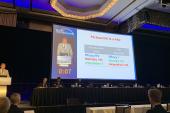BEST-CLI: Experts at ISET Look to Bridge Research Results and Practice
Though gaps remain between what the trial found and real-world CLTI care and outcomes, those don’t undermine its contribution.

MIAMI BEACH, FL—Two months after the long-awaited BEST-CLI trial results were released, ranking surgery over endovascular therapy as the best first option, when possible, for revascularization in chronic limb-threatening ischemia (CLTI), clinicians and researchers continue to grapple with the results.
Here at ISET 2023, a special session on the meeting’s final day showed some progress has been made in understanding where BEST-CLI fits into real-world practice.
Kenneth Rosenfield, MD (Massachusetts General Hospital, Boston), co-PI of the trial, emphasized the broad scope of BEST-CLI’s questions. “The goal was to compare clinical effectiveness, functional outcomes, and cost in patients with CLTI and infrainguinal PAD . . . who are candidates for both open surgery and endo first,” he told ISET attendees.
In essence, there were two parallel trials, he explained: patients with versus without an adequate single segment great saphenous vein (SSGSV) that could be used for bypass. For cohort 1, the hypothesis was that SSGSV-based bypass would outperform endovascular therapy, and for cohort 2, it was thought that endovascular therapy would outperform open surgery.
As reported by TCTMD, BEST-CLI, presented at the 2022 American Heart Association meeting and simultaneously published in the New England Journal of Medicine, found that for the 1,434 CLTI patients with a suitable SSGSV, surgery yielded a lower combined rate of major adverse limb events (MALE) and death than endovascular therapy in the first few years after treatment (42.6% vs 57.4%; P < 0.001). But for the 396 patients who didn’t have that option, the difference between the two groups didn’t reach statistical significance (42.8% vs 47.7%; P = 0.12).
“What I take a way, right off the bat, is I think this [trial] does reexamine and raise awareness that bypass can be effective in a certain segment of [patients with CLTI],” Richard F. Neville, MD (Inova Health System, Falls Church, VA), said in his presentation. “I also think that both forms of revascularization have been shown to be both effective and fairly safe.” That underlines the need for centers of excellence and multidisciplinary teams that can, in cooperation, weigh the various options while keeping the available data—with its strengths and limitations—in mind.
The Caveats
All standard-of-care endovascular therapies were allowed in BEST-CLI, as were all surgical bypass techniques and conduits, Rosenfield noted. Of the 1,096 investigators, three-quarters were vascular surgeons, while the rest were interventional radiologists (14%), interventional cardiologists (13%), and other specialists.
As a “pragmatic” trial that gave a lot of leeway to participating sites, BEST-CLI did suffer from some limitations, Rosenfield acknowledged. “I’m pretty certain there was a fair amount of selection bias and operator bias in terms of who they enrolled and the interventions that they performed.” There was procedural heterogeneity, especially in the endovascular therapy group, he added. Plus, it’s likely that cohort 2 was a bit underpowered.
“Most important, probably, the anatomic complexity of patients who were enrolled has yet to be evaluated. We don’t know whether there was a difference . . . compared to the average, ordinary CLTI patient—hopefully, we’ll get to that,” said Rosenfield.
This conversation is not at all about whether this trial should have been done. [BEST-CLI] should have been done and it’s an incredibly important trial. Eric A. Secemsky
There is one relatively simple takeaway message, he suggested: although both surgery and endovascular therapy are effective and safe, surgical revascularization comes out ahead for patients with a suitable SSGSV. “Patients who are candidates for limb salvage should undergo an evaluation of surgical risk and conduit availability. Bypass with adequate saphenous vein should be offered as a first-line treatment option for suitable candidates with CLTI, as part of fully informed, shared decision-making,” Rosenfield concluded.
Eric A. Secemsky, MD (Beth Israel Deaconess Medical Center, Boston, MA), also a presenter at the ISET 2023 session, said the field was nearly a “data-free zone” prior to BEST-CLI, with the 2005 BASIL study being the only other randomized trial. This contrasts with the cardiovascular realm, where the question of CABG versus PCI has been studied in more than 13,000 patients and post-PCI antiplatelet therapy in more than 115,000.
“We need to think about how we generate this type of data [on CLTI] moving forward. This conversation is not at all about whether this trial should have been done. [BEST-CLI] should have been done and it’s an incredibly important trial,” said Secemsky. Among other things, it “showed us what modern surgical bypass techniques could do.”
He, too, pointed to some limitations, such as inclusion of major reintervention in the primary endpoint, nonsurgical specialists being in the minority, and lack of generalizability (eg, enrollment wasn’t consecutive and most sites had fewer than 10 participants).
Notably, both technical failure and need for major reintervention were at the discretion of the unblinded operator, he said. “We know that there is a lot of opportunity to make judgement calls at the local level, [though] this is part of clinical trials.” As an example, Secemsky cited the finding that early crossover from endovascular to bypass accounted for 16.2% of primary-endpoint events in cohort 1.
The Case for Surgery
But how to bridge the gap between a trial setting and practice? Doing so will require an understanding of what today’s surgical bypass can achieve in real-world use, Neville asserted.
At centers participating in the Vascular Quality Initiative registry, on average 30% of revascularizations for CLTI are bypass. Most surgeries are done using the SSGSV, he noted, but this isn’t an option for 30-50% of patients, for whom the vessel has “been taken for another bypass, it’s been taken by the heart surgeons who beat us to it, maybe it’s been stripped because it’s varicose [or] some other reason.”
If we don’t have a vein to use, we still have options if endovascular therapy is not a good option. Richard F. Neville
Just like in the endovascular space, there’s variation in how the surgery is done, with different methods for vein harvesting and bypass grafting. Although in earlier years studies showed prosthetic veins aren’t as good as the real thing, “we’ve come a long way,” he said. Examples are the distal vein patch (DVP) technique and heparin-bonded expanded polytetrafluoroethylene (ePTFE) grafts. Adjunctive medical therapy such as clopidogrel or low-dose direct oral anticoagulants can also improve outcomes.
“If you’ve got a single-segment saphenous vein, I totally agree with the trial: those are the patients we need to focus on, [because] they will do better. But if we don’t have a vein to use, we still have options if endovascular therapy is not a good option,” Neville stressed.
He said that at his own center, due to the complexity of the cases, prosthetic grafts now predominate, most often using the DVP technique. They’ve begun looking at provider-level volume and quality to “see if that makes a difference,” he noted.
As BEST-CLI shows, SSGSV remains optimal. Prosthetic grafts, when necessary, “are comparable in many ways, . . . but there might be minimal experience and some additional training we need to do to gain the kind of results we saw” in a trial setting, Neville concluded.
Endovascular Therapy in BEST-CLI
Sanjay Misra, MD (Mayo Clinic, Rochester, MN), set the tone for his presentation by drawing attention to the scope of the problem posed by PAD. “Awareness among our medical specialists is very low. [There are] 150,000 nontraumatic amputations per year, and we still have difficulty getting patients revascularized,” said Misra.
In applying the lessons of BEST-CLI to meet this challenge, it’s important to delve into the trial’s endovascular arm, he added.
The total number of major reinterventions in patients randomized to an endo-first strategy was more than twice that of the surgical arm, driven by early failure in the endovascular group. Approximately 42% of all first major reinterventions occurred within 30 days.
Looking at the data, said Misra, “the things that really stuck out at me are the reintervention rates and the MALE rates. Why do the [curves] separate so early and then stay parallel? If you can understand those [patterns], you can really unravel the whole conundrum.
Patient demographics provide a clue: 10% had end-stage renal disease, which Misra noted is “a failure mechanism for any type of treatment.” Moreover, the rate of technical success was just 84.7% in the trial, raising the question of whether this reflects what’s going on in actual practice and if physicians are being properly trained to do endovascular procedures, he said.
Going forward, “we need to understand our own technical success rate and really aim for greater than 90%, [which] in most high schools is an A—so I would say we all need As,” advised Misra. Reinterventions should be avoided as much as possible, and survival free from MALE/amputation should reach around 70% at 1 year. “Every center needs to know their own [performance] data, and I would [suggest] even every interventionalist needs to know their own data,” he added.
Real-World Decisions
Irrespective of particular quibbles with the BEST-CLI trial design, Secemsky said he strongly agrees that SSGSV-based bypass “is and should remain a primary revascularization strategy among those eligible.” The need to screen more frequently for suitable veins is also a clear message from BEST-CLI, he added, as is the importance of multispecialty teams.
However, “patient preference is going to be a huge part of this” decision-making, Secemsky specified. That, along with “surgical candidacy, prognosis, suitable anatomy, technical proficiency, costs, and timely access to care are how we now have to figure out how to disseminate this and incorporate this in our practice. These are all major issues.”
Session co-moderator Barry Katzen, MD (Miami Cardiac & Vascular Institute, FL), turned to discussant Robert Lookstein, MD (Icahn School of Medicine at Mount Sinai, New York, NY), for his thoughts on how to “deal with this mismatch that’s been pointed out between what we’re seeing in real-world outcomes . . . versus BEST-CLI.”
Lookstein said that when his center’s vascular surgeons and interventional radiologists got together to discuss the study after its publication, they were “disappointed” by the acute technical failure seen in its endovascular arm.
We have a lot of unpacking of this trial to do to really fully understand its implications, and hopefully we’ll have more data coming forth. Kenneth Rosenfield
What they realized was that some in their multispecialty group were experts in bypass, while others were experts in endovascular therapy—not necessarily both. The lesson from BEST-CLI, then, is for these clinicians to “practice as they see fit and practice according to their skill set,” he said. On the other hand, it’s “a call to action to the people who sort of dabble in this,” who are doing a handful of these cases a year, to “strongly consider” referring their patients to someone with higher volumes, Lookstein noted.
For Ramon L. Varcoe, MBBS, PhD (Prince of Wales Hospital, Randwick, Australia), the lack of technical success points toward selection bias, both within sites (not enrolling patients thought to be “easy endovascular candidates”) and in which centers participated in the trial. “Many CLI centers around the world [with] experts that achieve high technical success rates actually refused to go in this trial, because they had no equipoise,” he said.
This begs the question of how the findings would be applicable to centers of excellence or experienced CLTI specialists, Varcoe noted, and raises the issue of whether the patients studied represent who’s seen in actual practice.
Katzen pointed out there was “no real tracking of screening” for eligibility, which might have shed light on the latter. He asked Rosenfield: “What are your thoughts about how the subset of patients represents the general population?”
“I wish I could answer that,” Rosenfield replied, noting that he appreciates the selection-bias concerns. “We don’t know. We did not have a screening log per se. . . . Because of that, we really don’t know what was the makeup of patients who enrolled versus those who either were not considered, or were considered but not enrolled.”
Novo Nordisk has provided a continuation grant that will allow the BEST-CLI researchers to retrieve and analyze angiograms for anatomic complexity, said Rosenfield. “We have a lot of unpacking of this trial to do to really fully understand its implications, and hopefully we’ll have more data coming forth.”
Caitlin E. Cox is News Editor of TCTMD and Associate Director, Editorial Content at the Cardiovascular Research Foundation. She produces the…
Read Full BioSources
Various presentations: Surgery vs endovascular therapy: is the BEST trial going to change clinical practice? Presented at: ISET 2023. January 19, 2023. Miami Beach, FL.
Disclosures
- Rosenfield reports serving as a consultant to or on the advisory boards of Abbott Vascular, Althea Medical, Angiodynamics, Auxetics, Becton-Dickinson, Boston Scientific, Contego, Crossliner, Innova Vascular, Inspire MD, Janssen/Johnson and Johnson, Magneto, Mayo Clinic, MedAlliance, Medtronic, Neptune Medical, Penumbra, Philips, Surmodics, Terumo, Thrombolex, Truvic, Vasorum, and Vumedi; receiving grants/research funding to his institution from the National Institutes of Health, Abiomed, Boston Scientific, Novo Nordisk, Penumbra, and Gettinge-Atrium; holding equity in Accolade, Access Vascular, Aerami, Althea Medical, Auxetics, Contego, Crossliner, Cruzar Systems, Embolitech, Endospan, Imperative Care/Truvic, Innova Vascular, InspireMD, JanaCare, Magneto, MedAlliance, Neptune Medical, Orchestra, Prosomnus, Shockwave, Skydance, Summa Therapeutics, Thrombolex, Valcare, Vasorum, and Vumedi; and being a board member and founder of the National PERT Consortium.
- Neville reports being on the scientific advisory boards of WL Gore and Alio.
- Misra reports serving as a consultant to Medtronic Inc, being an employee/owner of Pavai Vascular, and receiving other financial or material support from Humacytes, Inova Vascular, and Penumbra.
- Secemsky reports funding from the National Institutes of Health, Food and Drug Administration, and UCSF; grants to his institution from BD, Boston Scientific, Cook, CSI, Laminate Medical, Medtronic, and Philips; as well as speaking/consulting for Abbott, BD, Bayer, Boston Scientific, Cook, CSI, Inari, Medtronic, Philips, Shockwave, VentureMed.





Comments